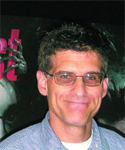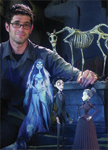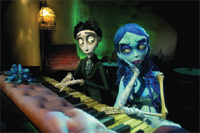
Daniel Restuccio
|
LONDON - Boy meets girl, boy practices wedding vows by putting ring on finger of dead girl, boy marries corpse. That's the macabre spin to a classic romance story in Warner Bros.' animated tale, Corpse Bride. Directed by Tim Burton and Mike Johnson, this gravely enchanting tale comes to the big screen as the first digital stop-motion feature film.
"What I love about stop-motion animation is that it's so tactile," says Burton. "There's something wonderful about being able to physically touch and move the characters, and to see their world actually exist. It's similar to making a live action film - if you're doing it all on bluescreen, it doesn't give you the feeling of actually being there, which the stop-motion process does."
"The Nightmare Before Christmas [directed by Burton] spawned a new generation of stop-motion fans," says Johnson, who was an assistant animator on that film, "it has a certain texture, a presence, that just can't be achieved with computers."

Mike Johnson co-directed Corpse Bride with Tim Burton.
|
The Corpse Bride plot is based on a 19th Century Russian folktale given to Burton 10 years ago by close friend and Pixar story guru Joe Ranft, who tragically died in a car accident on August 16. The original tale tells of a young man who accidentally becomes married to a living corpse and how he escapes his ghoulish fate. That original story was transformed by Burton, and screenwriters John August, Caroline Thompson and Pamela Pettler, into a tale of ambition, snobbery, hypocrisy, murder, fate, destiny, the afterlife, and ultimately compassion.
Production and post took place in and around London. Voicing the film's lead characters are Johnny Depp as Victor, Helena Bonham Carter as the Corpse Bride and Emily Watson as Victoria. Character designer Carlos Grangel designed fully-animatable puppets based on original character sketches made by Burton. Puppet masters McKinnon and Saunders brought these designs to life. They devised foot-tall figures with a new flexible silicon skin and heads that contained an intricate adjustable gearing mechanism capable of producing complex facial expressions and unprecedented subtly of emotion.
Meanwhile storyboard artists were busy blocking out the all the scenes shot by shot and filling the panels with the dark and brooding mood that Burton is famous for.
THE EDIT
In the hands of editor Jonathan Lucas, voice tracks and storyboards converged into a precise 75-minute previsualization of the finished movie. Lucas built the story reel in Apple's Final Cut Pro 4.5.
"Shooting this movie digitally was, for me, almost instant gratification," says Lucas. "Once a shot was complete I had it cut into the reel within a few hours. This movie couldn't have been done any other way. The amount of time it would have taken if the film had to be processed and telecined before being cut, we would never have hit the release date or been able to get the instant feedback that was allowed us by this new digital technology using Final Cut Pro."

Boy marries corpse: This feature was initially going to be shot on film, but a digital pipeline was found to offer numerous benefits. Customized Canon digital still cameras made it possible.
|
Burton's long-time editor Chris Lebenzon, ACE, who recently wrapped up work on Charlie and the Chocolate Factory, oversaw the edit and further developed it within Avid.
GOING DIGITAL
During preproduction, Corpse Bride producer Allison Abbate, freelance VFX supervisor Chris Watts and Warner Bros. visual effects senior VP Chris DeFaria were having dinner in London and discussing the project. Watts mentioned casually, "Well, you're shooting this digitally, right?" The startling suggestion was quickly discussed and ultimately adopted for the production.
The original plan was to shoot on film, but "when Chris DeFaria and Chris Watts heard about the cumbersome process of shooting one frame at a time and then waiting a day for dailies, they suggested using these digital still cameras. Their size and availability made perfect sense for us, so with six weeks to go before we began principal photography, we decided to make the switch. Everyone really rallied behind the move. It was a big learning curve but the excitement and the advantages made it worth the work."
Watts spent the next months devising and refining a workflow based on using a digital still camera to do stop motion animation. After testing many cameras, the field narrowed to the Canon EOS-1D Mark II equipped with a CMOS 8.2 megapixel chip and Digic II processor. In the final movie some shots were captured by other cameras, but most of the movie was shot with 32 customized Canons on 32 separate sets at Three Mills Studios in London.
Watts, director of photography Pete Kozachik and motion control technician Andy Bowman modified the SLR camera back, attaching a video tap that swung out for precise focusing. A distinct advantage of the smaller camera, mounted on a computer motion controlled jib arm, was the ability to get deep and tight into a scene and way up close to a puppet character.
Watts devised a base line calibration system that emulated the color space and gamma of Kodak 5248 negative, the film stock Kozachik selected when the project was celluloid based. He rated the cameras at ISO 100 and sometimes ISO 50 when shooting really dark subject matter. He also lit every set film style, and captured every frame in the native camera 3504 x 2336 raw format - the uncompressed data coming off the CMOS chip. Watts used a freeware program built by David Coffin, called dcraw.c, an ANSI C program that decodes any camera raw file. That code was incorporated into a custom application built by programmers at FilmLight, UK, to convert the camera raw files into standard Cineon images.
Each folder of Cineon frames represented a shot and was turned into a QuickTime clip. The editorial team methodically replaced all the storyboard clips with the QuickTime clips and built an elaborate temp audio track, filled with sound effects and temp music to get a better emotional sense of the final film.
THE BIG FINISH
While the majority of the movie was shot "in-camera," there were still over 460 digital effects shots created by Moving Picture Company (www.moving-picture.com/), or MPC, in London and supervised by Jessica Norman. Some shots were scene enhancements such as CG clouds, flames, cobwebs and smoke elements composited into many multilayered shots for atmosphere. Other digital tasks included rig removal, and modeling and animating crows, spiders, butterflies and the bride's diaphanous veil. MPC effects artists also extended the city and country backgrounds with digital matte paintings.
As the CG shots evolved, updated QuickTimes were sent to Lucas and incorporated into the offline.
MPC was also responsible for the online edit using their Quantel iQ to conform all the Cineon files and visual effects shots into a digital intermediate master. Max Horton used Pandora Pogle for final color grading on the DI. The final color corrected DI was sent to MPC's in-house Arrilaser recorders.
How does Abbate feel knowing that they've permanently changed the way that stop-motion feature animation is accomplished? "This was a great marriage between the worlds of high and low tech," she says. "We used the new technology to enhance and facilitate the hand-made charm of stop-motion animation. I think it will change the way people look at the medium. And this is only the beginning."